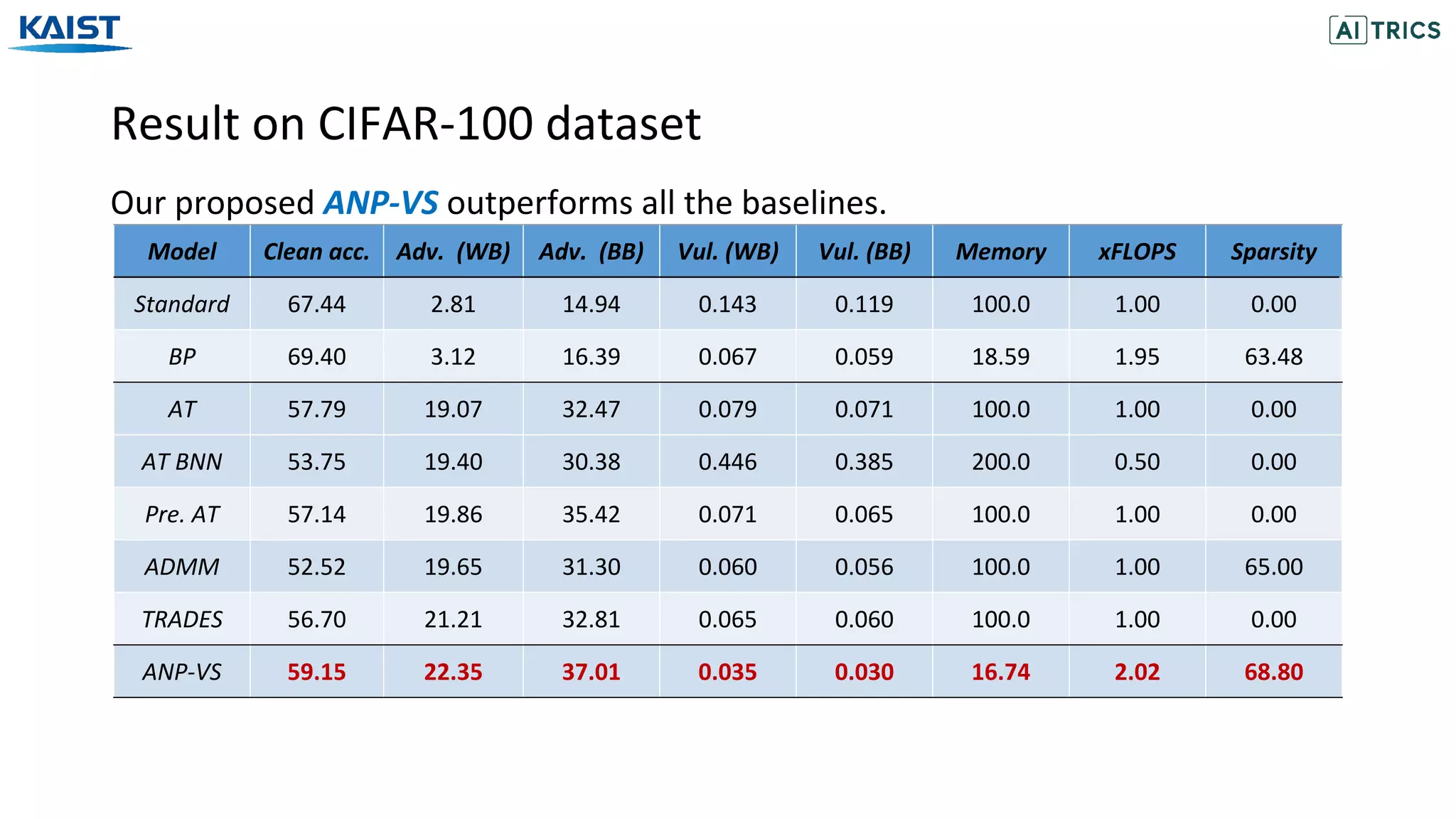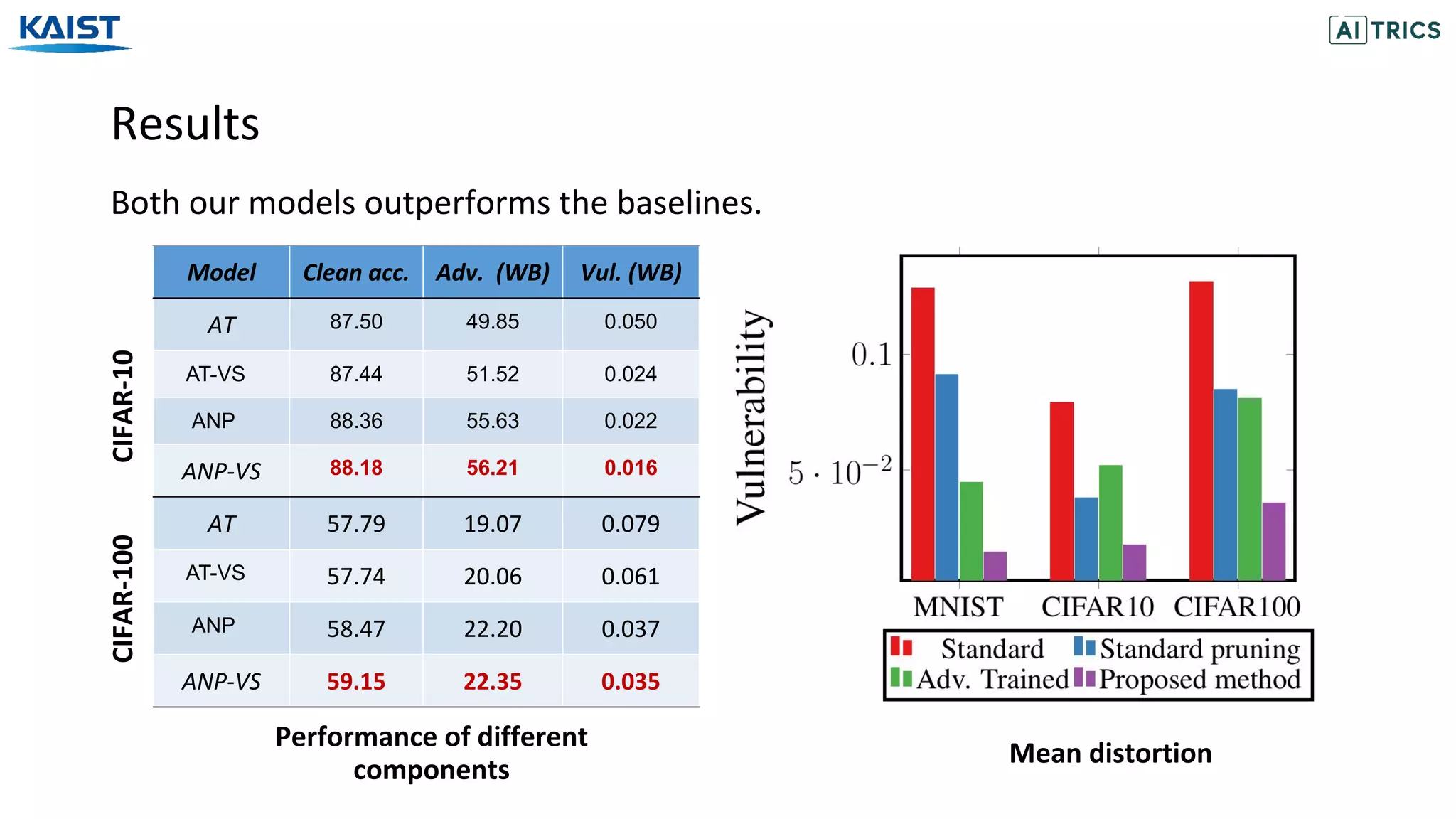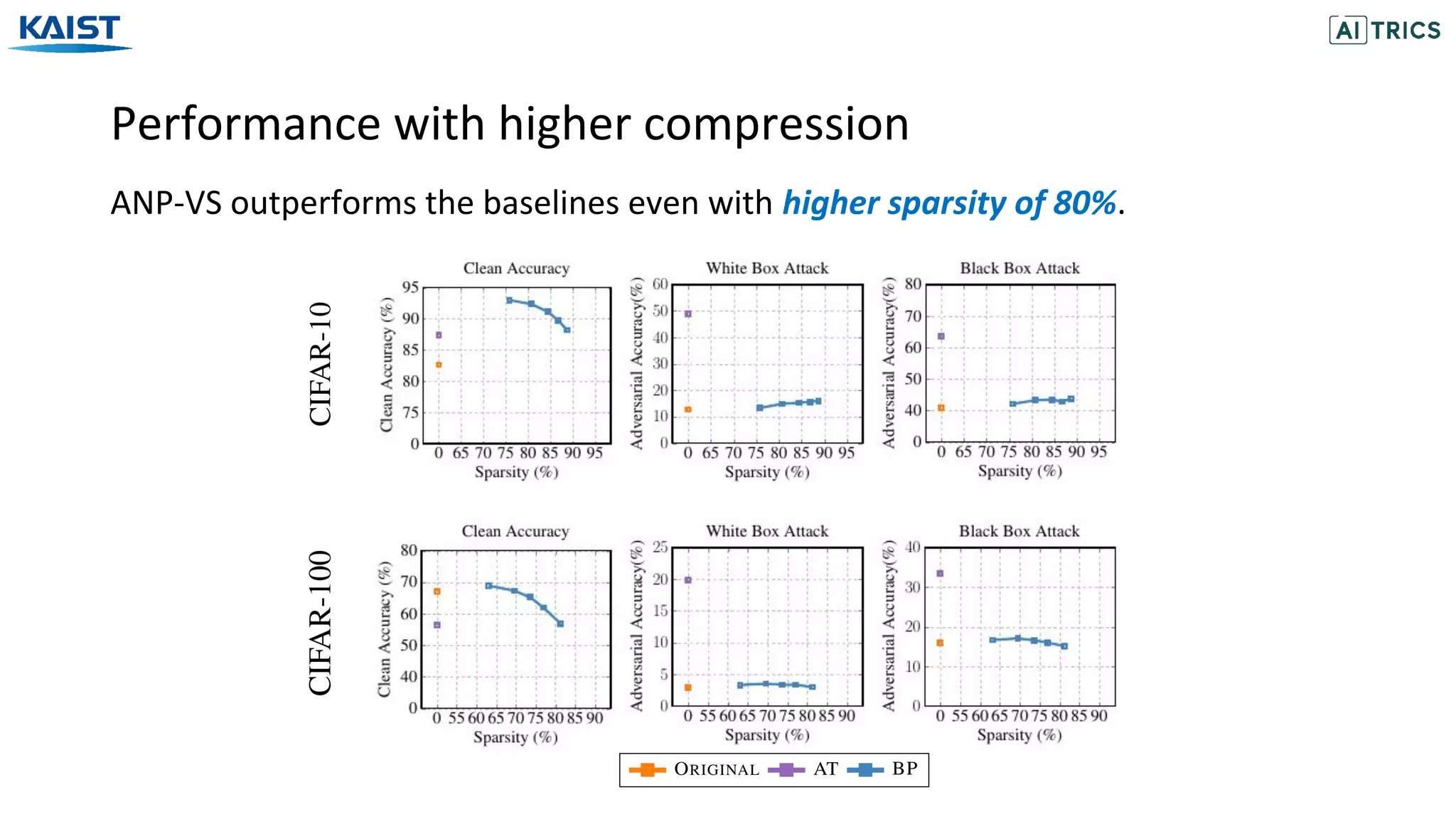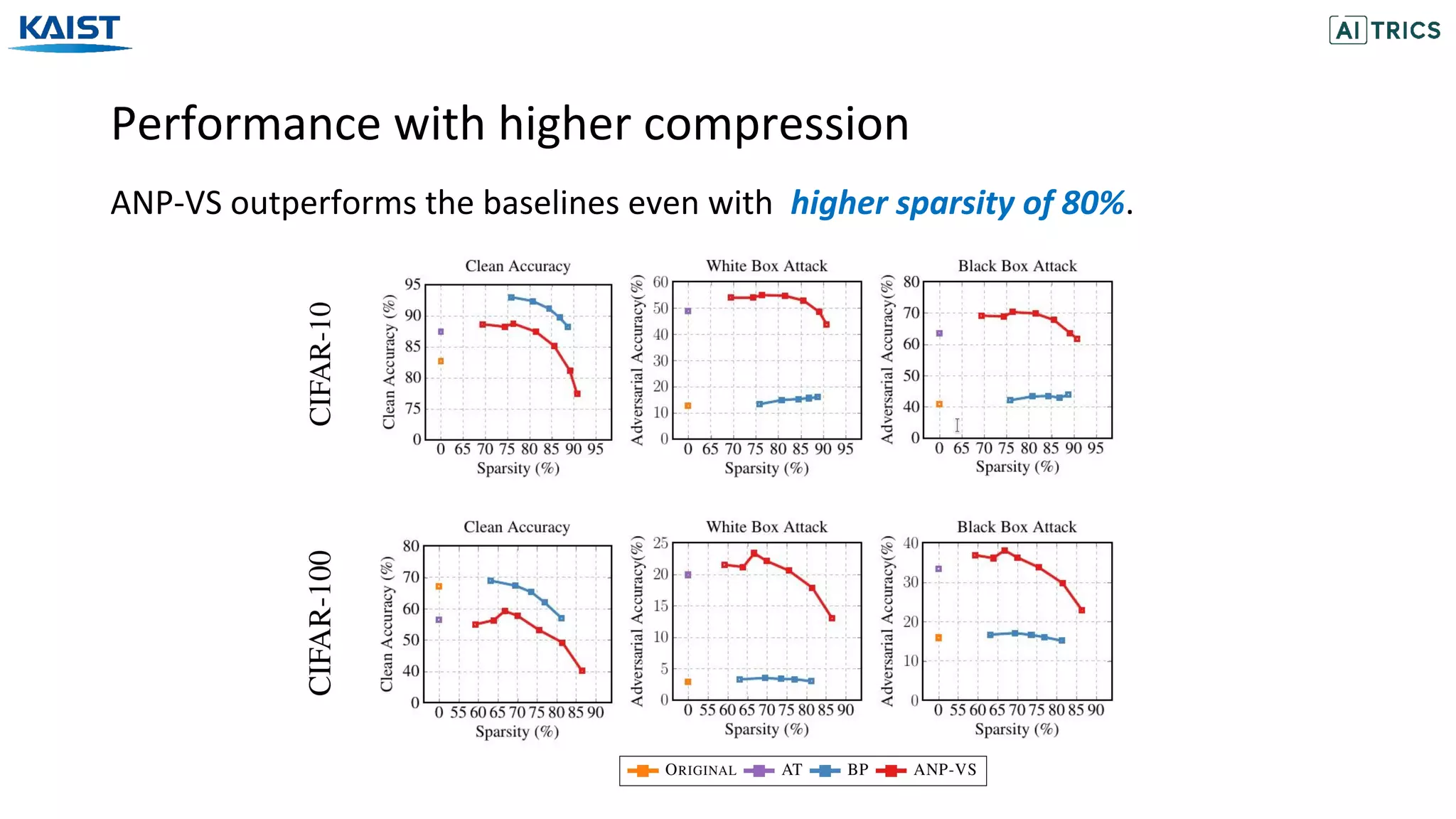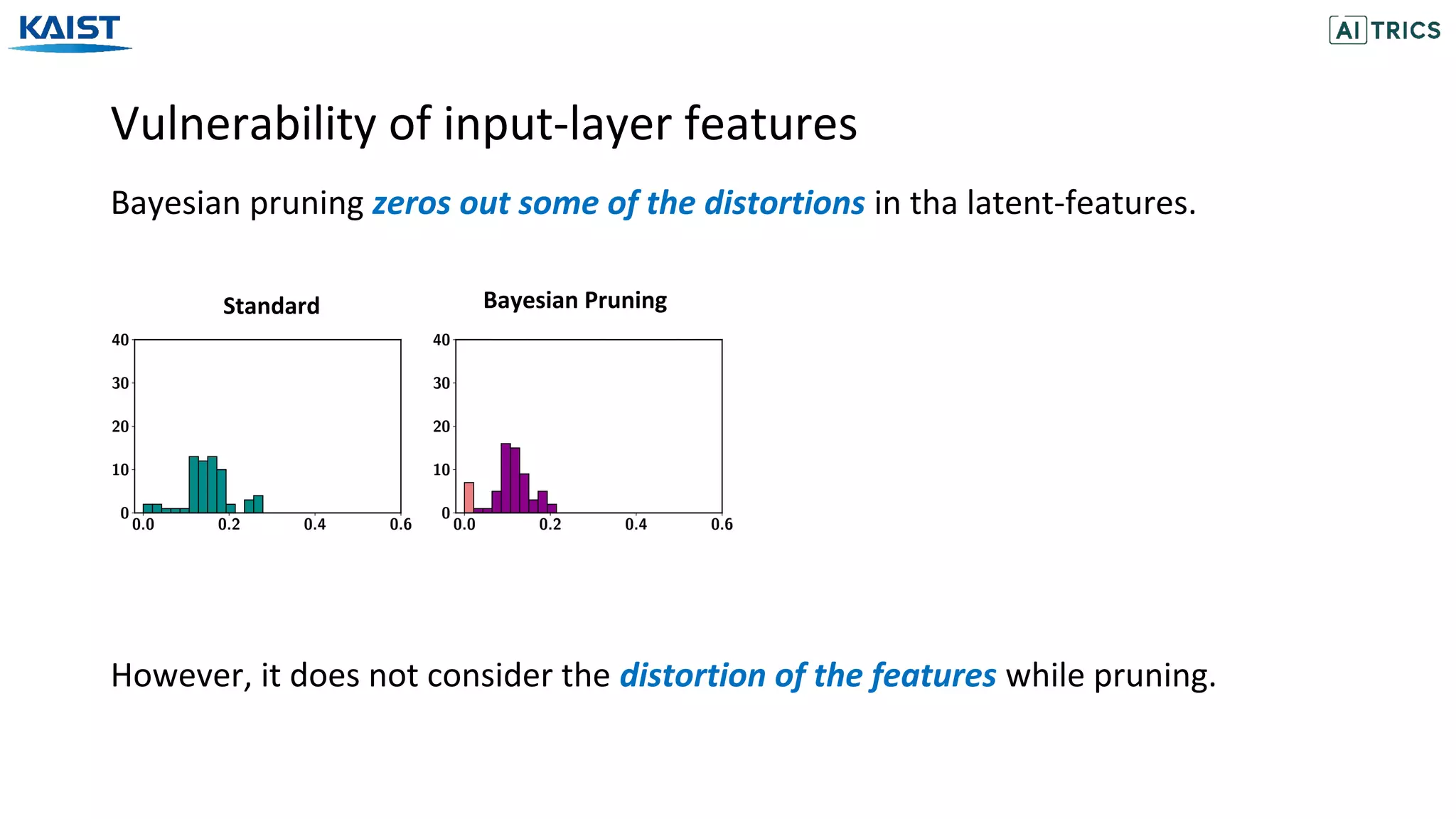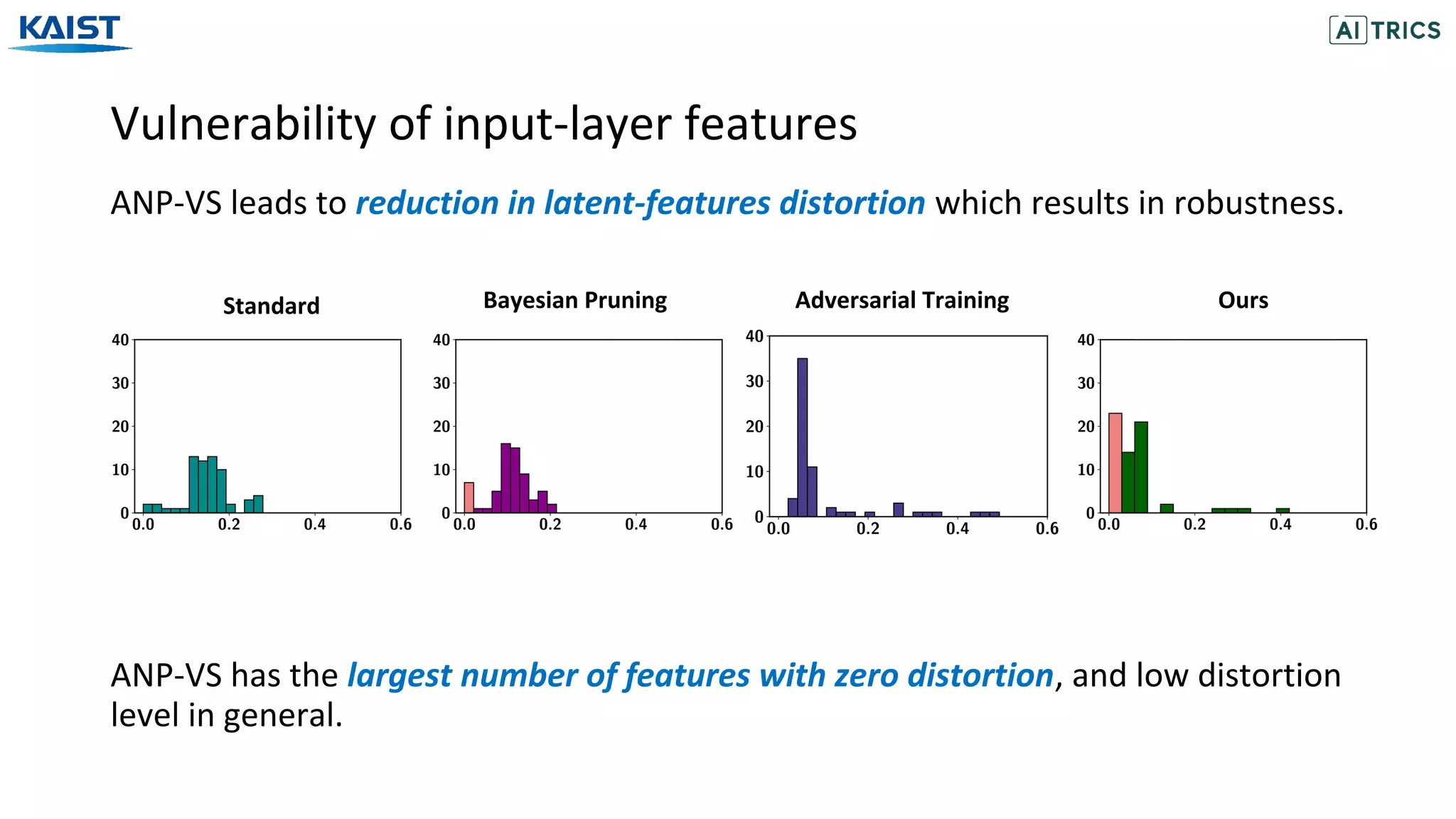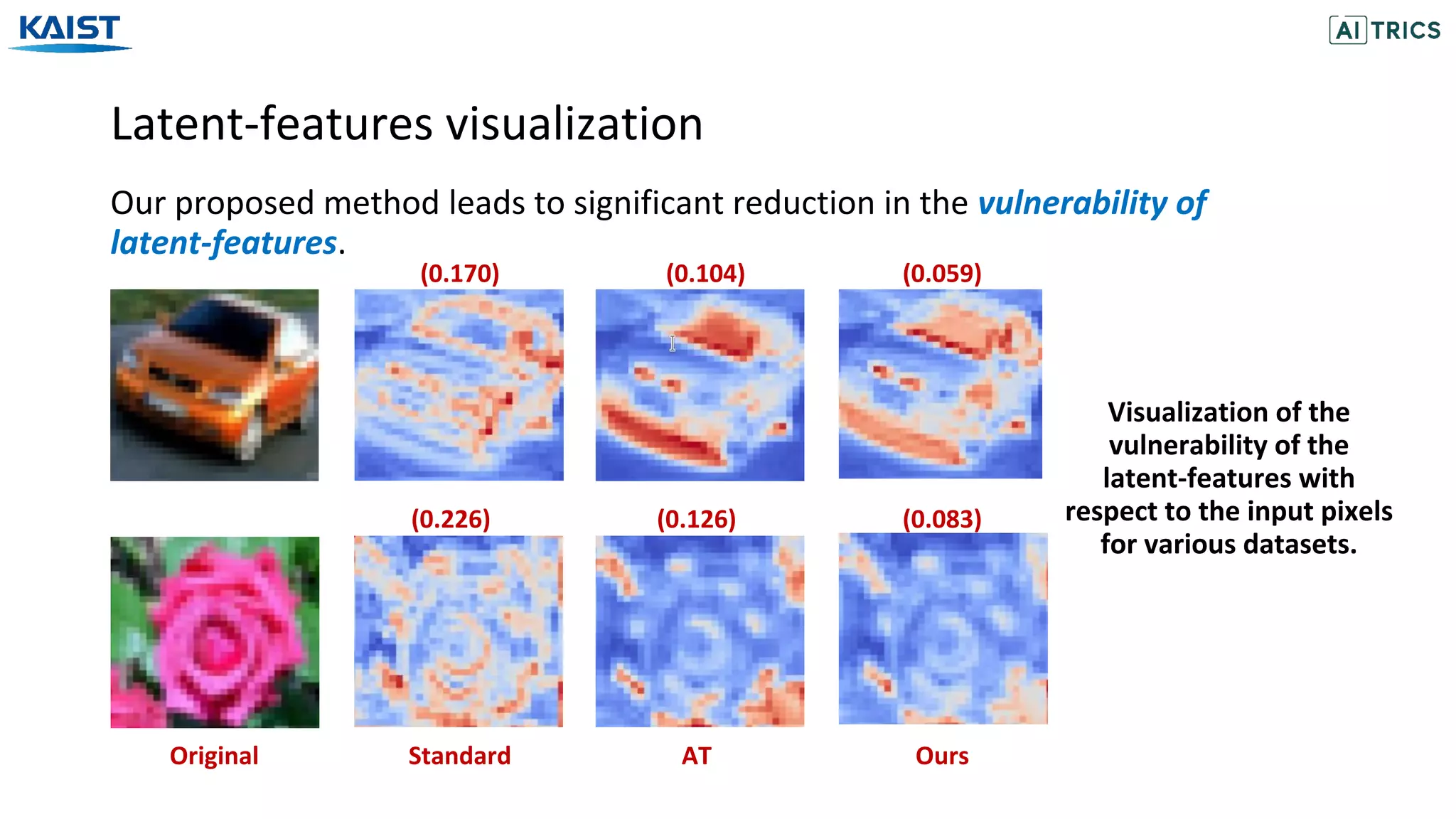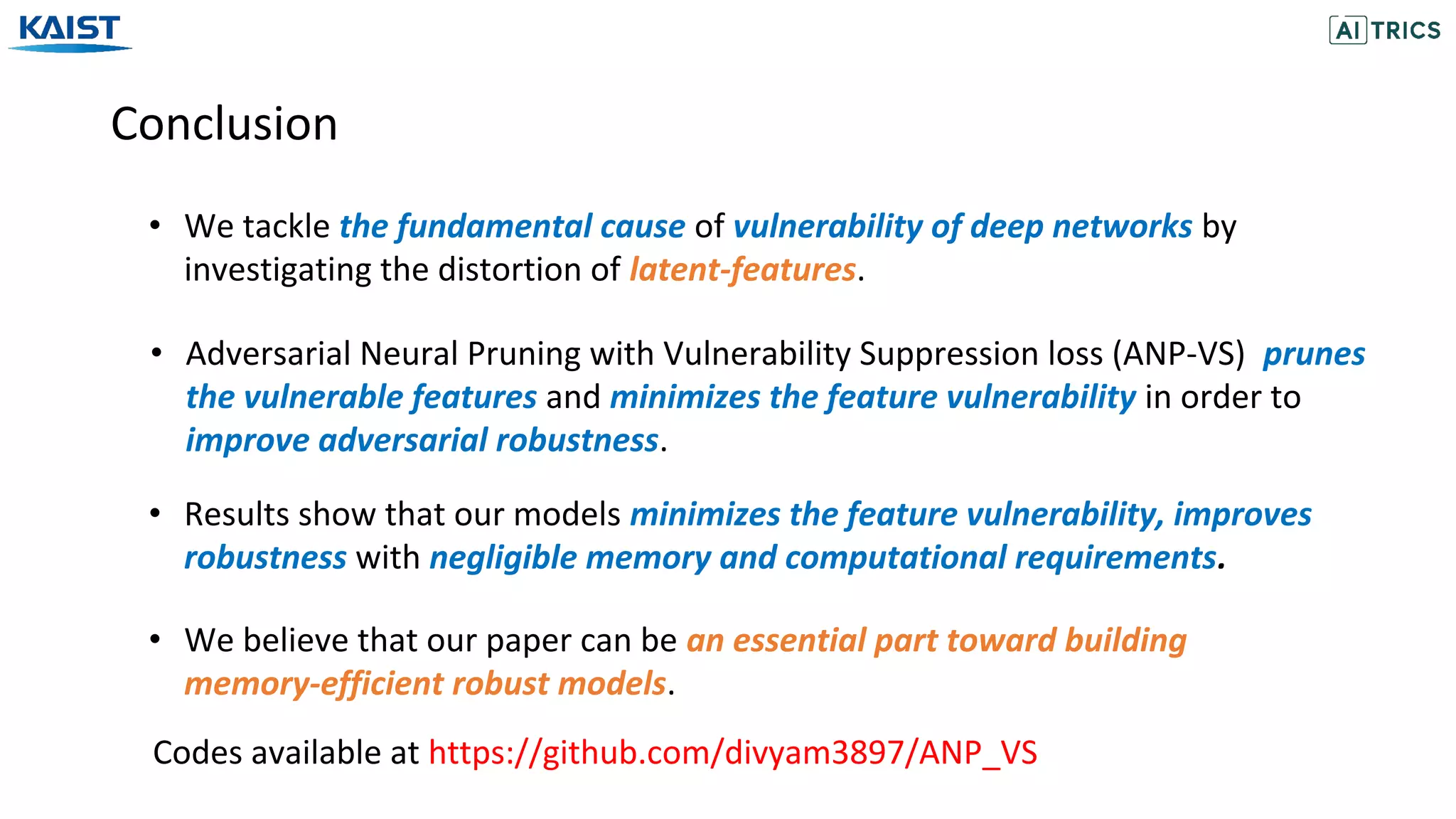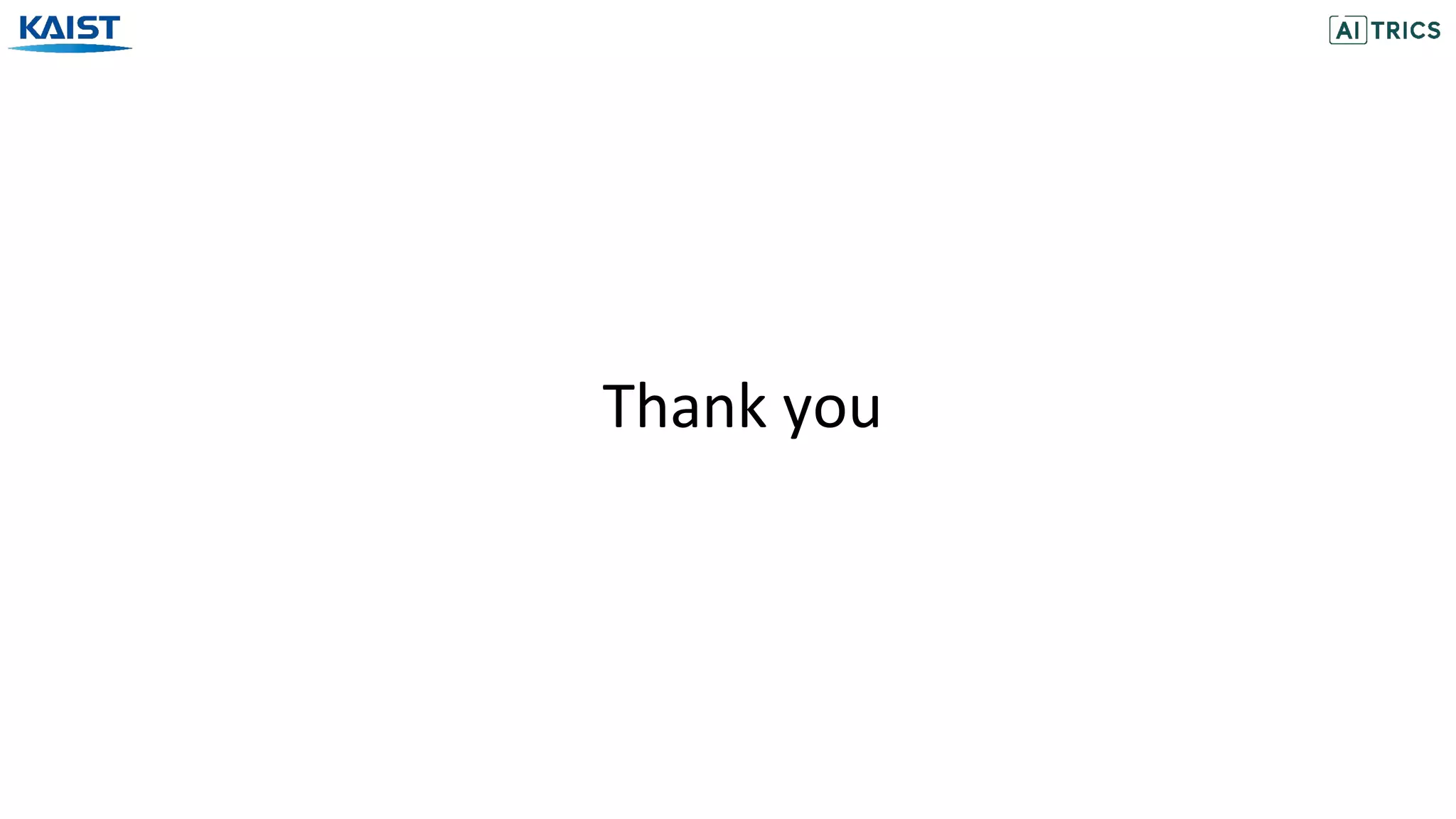This document presents a study on adversarial neural pruning (ANP) with a focus on latent vulnerability suppression to improve the robustness and efficiency of neural networks against adversarial attacks. The authors introduce the concept of vulnerability in latent-feature representations and propose a Bayesian framework for pruning vulnerable features to enhance model performance. Experimental results show that the proposed ANP with vulnerability suppression (ANP-VS) outperforms various baseline models across multiple benchmark datasets.

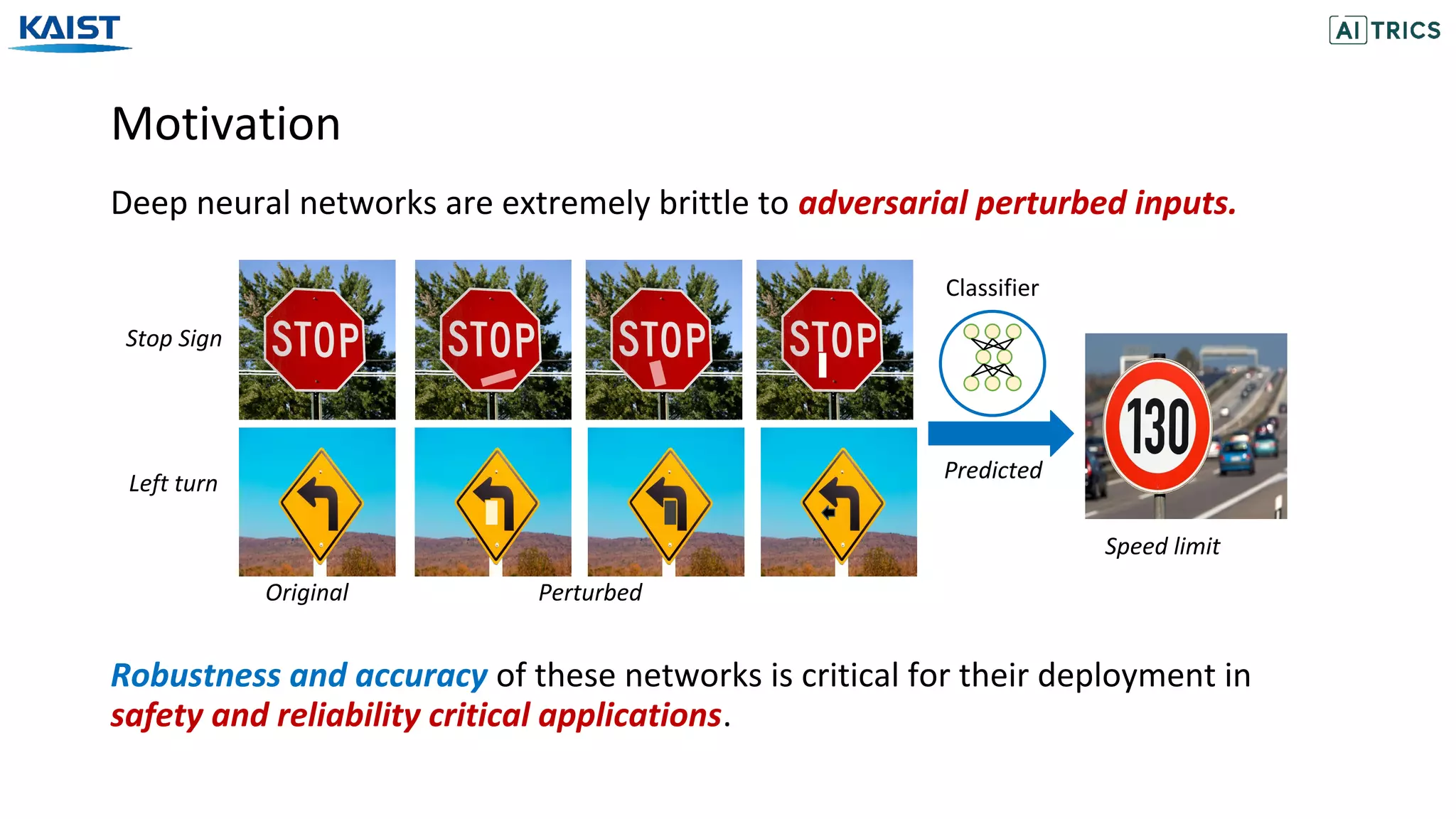
![Motivation
Deep neural networks rely on non-robust features for generalization to test set.
There exists a set of robust and non-robust features in the input space [Ilyas et al., 2019].
Dog
Classifier
Robust-features
Non-robust features
Dog
Cat
[Ilyas et al., 2019] Adversarial Examples are not Bugs, They are Features. NeurIPS 2019
In this work, we investigate the vulnerability of the latent-features of a network.](https://image.slidesharecdn.com/adversarialneuralpruningwithlatentvulnerabilitysuppression-200723082919/75/Adversarial-Neural-Pruning-with-Latent-Vulnerability-Suppression-3-2048.jpg)


![Related Work: Robustness and Sparsity
However, all these works test their hypothesis with heuristic pruning techniques.
Guo et al. (2019) and Ye et al. (2018) demonstrated that higher sparsity leads to
more robust model.
[Ye et al., 2018] Defending DNN adversarial attacks with pruning and logits augmentation. ICLR Workshop Submission, 2018
[Wang et al., 2018] Adversarial Robustness of Pruned Neural Networks. ICLR Workshop Submission, 2018.
[Guo et al., 2019] Sparse DNNs with Improved Adversarial Robustness. Neurips 2018
Robustness of VGG-like network (left) and
ResNet-32 (right) with varying weight sparsity
[Guo et al., 2019]
Robustness evaluation of pruned networks by
weight or filter pruning on MNIST dataset
[Wang et al., 2018]
In contrast, Wang et al. (2018) illustrated that higher sparsity decreases robustness.](https://image.slidesharecdn.com/adversarialneuralpruningwithlatentvulnerabilitysuppression-200723082919/75/Adversarial-Neural-Pruning-with-Latent-Vulnerability-Suppression-6-2048.jpg)
![Related Work: Robustness and Sparsity
However, it requires a pre-trained adversarial defense model and still does not take
into account the robustness of a latent-feature.
Ye et al. (2019) proposed concurrent adversarial training and weight pruning to
achieve robust and sparse networks.
[Ye et al., 2019] Adversarial Robustness vs. Model Compression, or Both? ICCV 2019
ADMM Robustness with VGG-16 (left) and ResNet-32 (right)
with varying weight sparsity on CIFAR-10 [Ye et al., 2019]
Model capacity Model capacity](https://image.slidesharecdn.com/adversarialneuralpruningwithlatentvulnerabilitysuppression-200723082919/75/Adversarial-Neural-Pruning-with-Latent-Vulnerability-Suppression-7-2048.jpg)
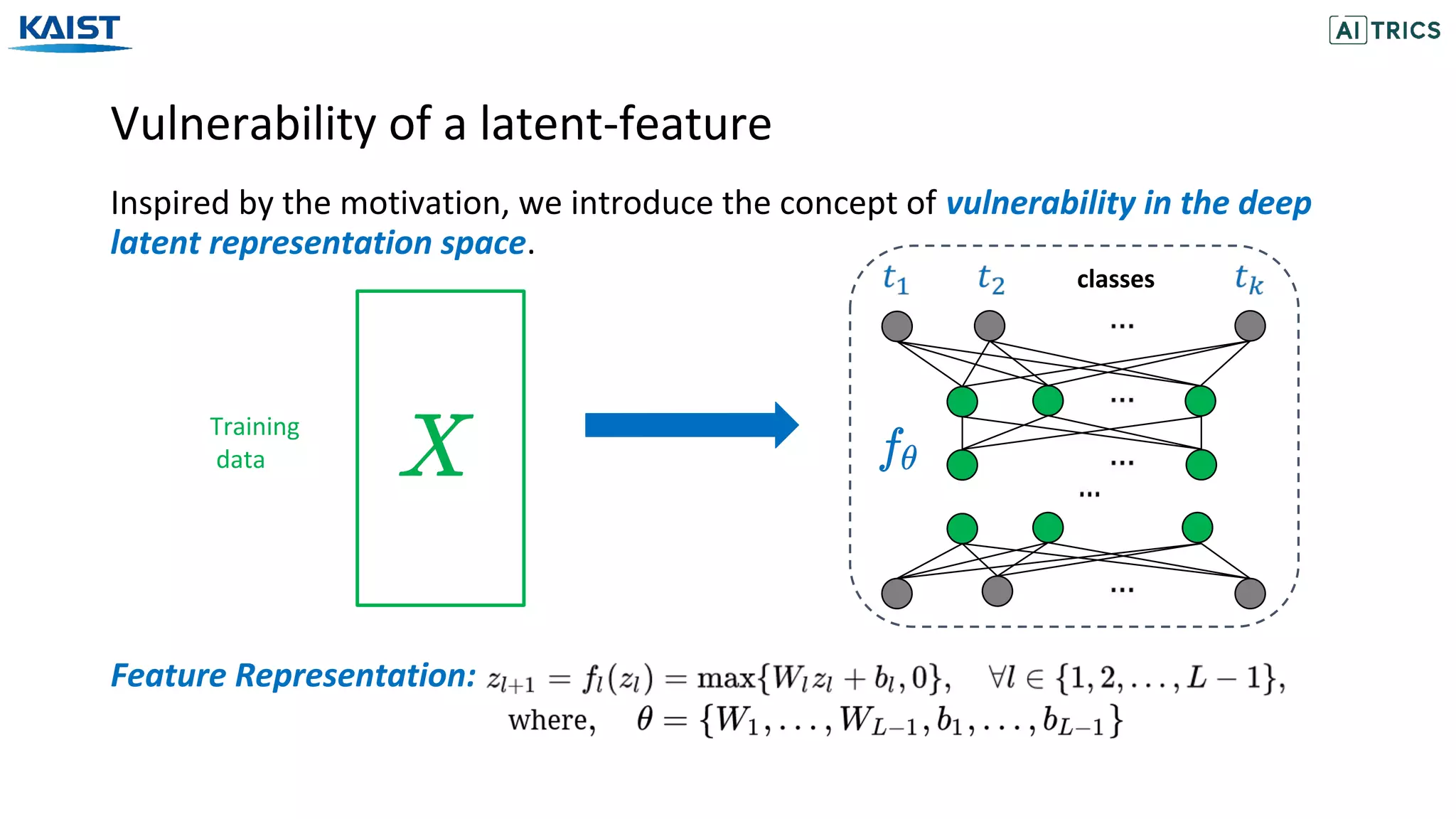
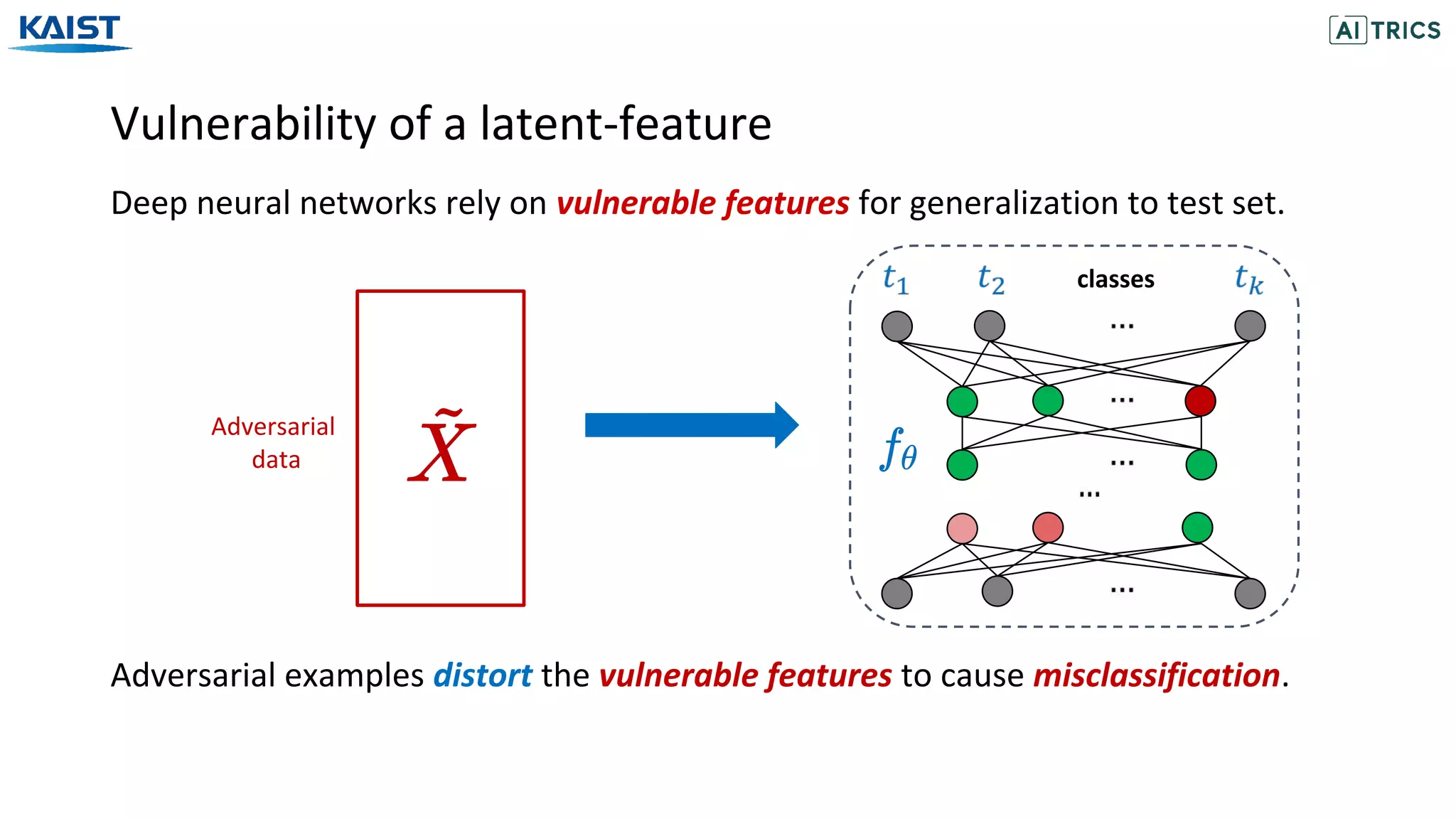
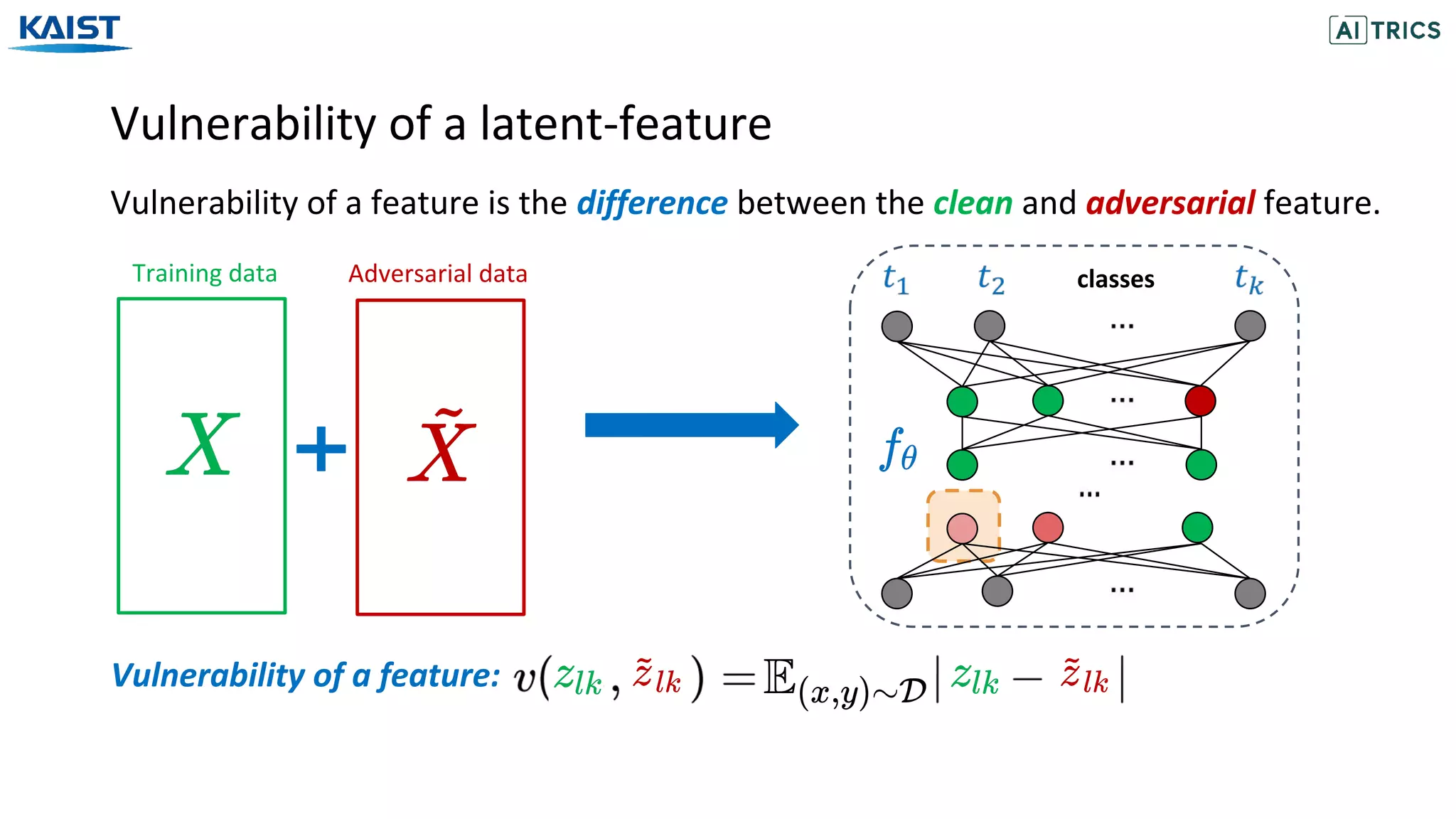
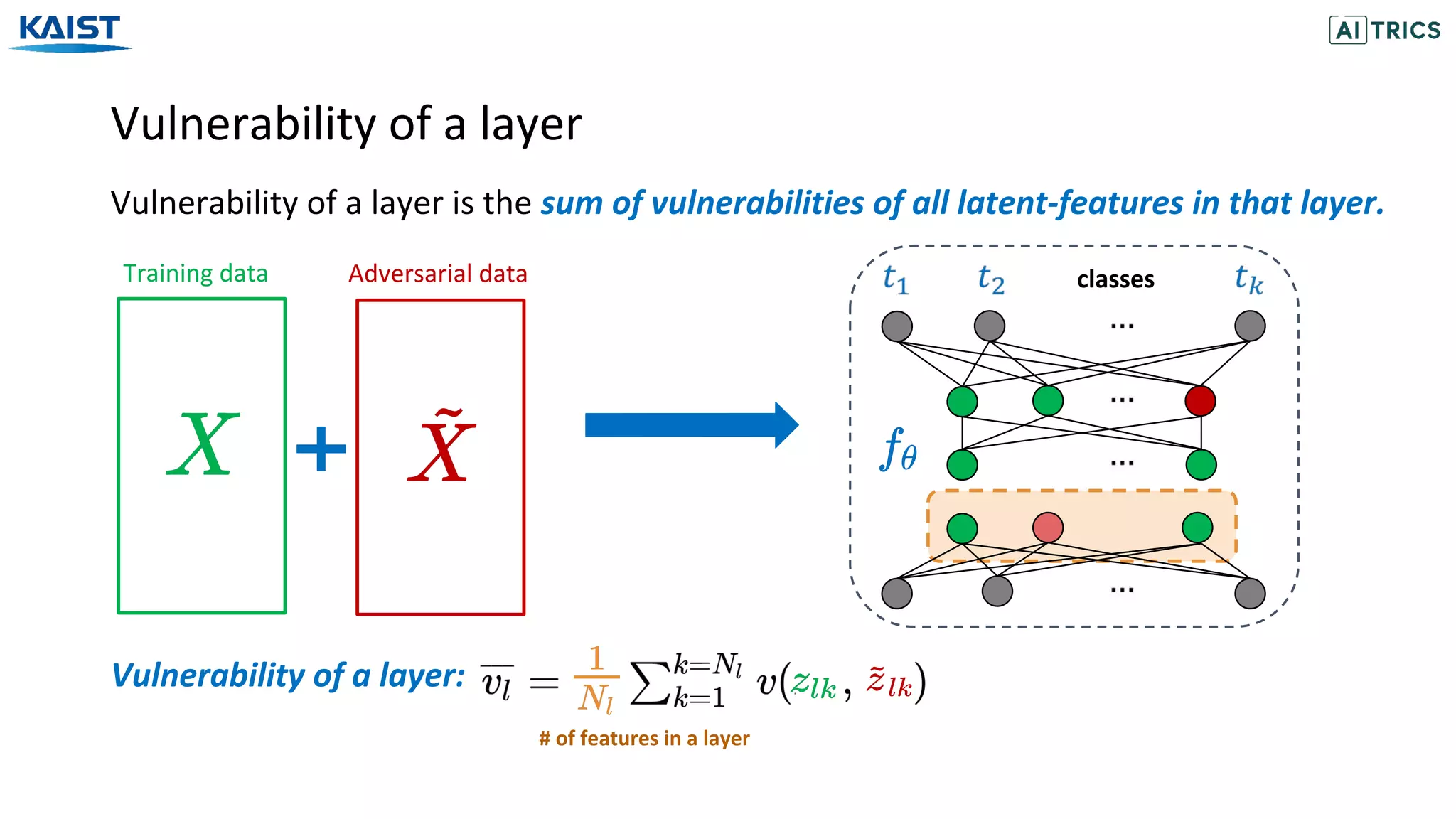
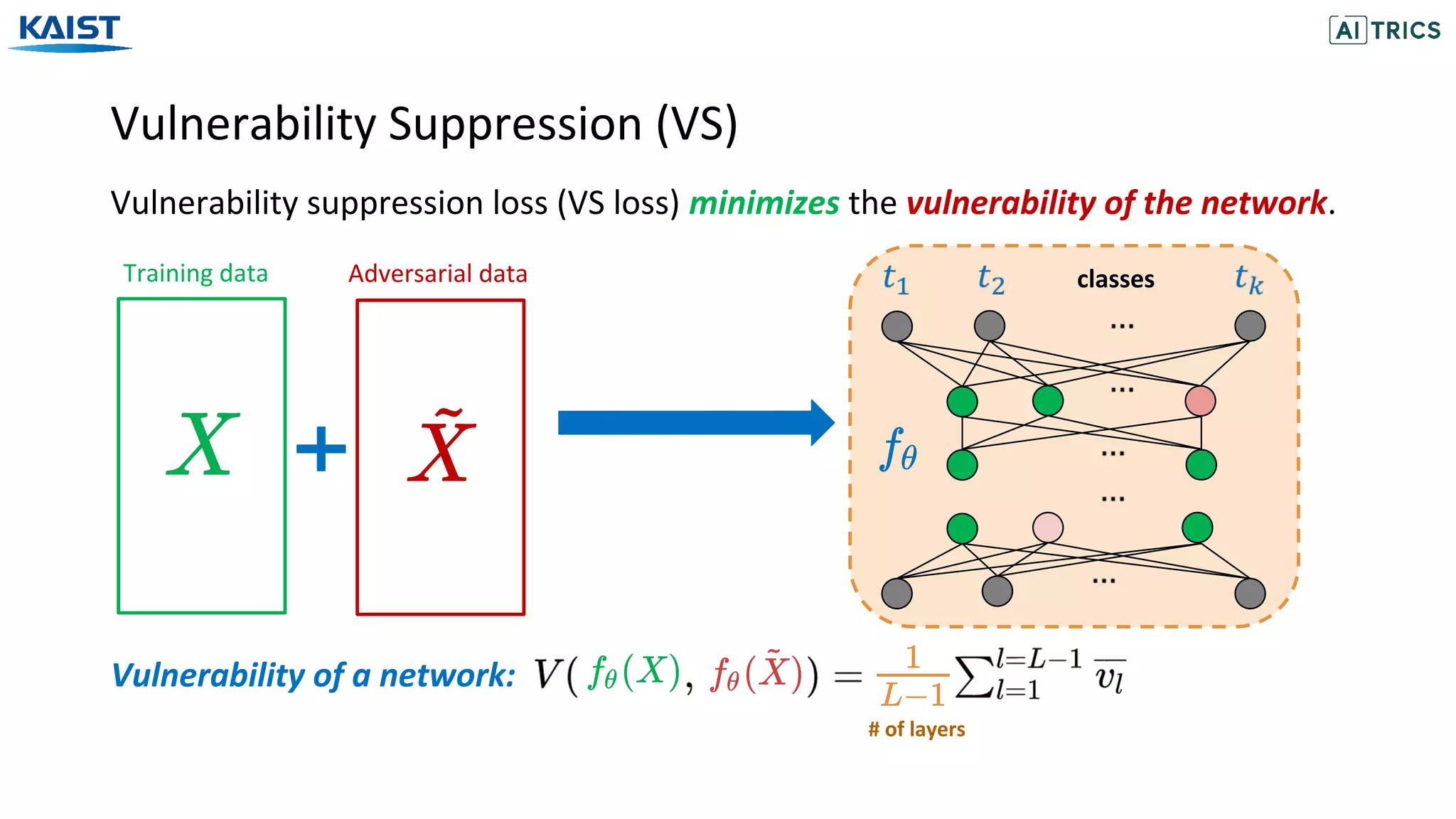

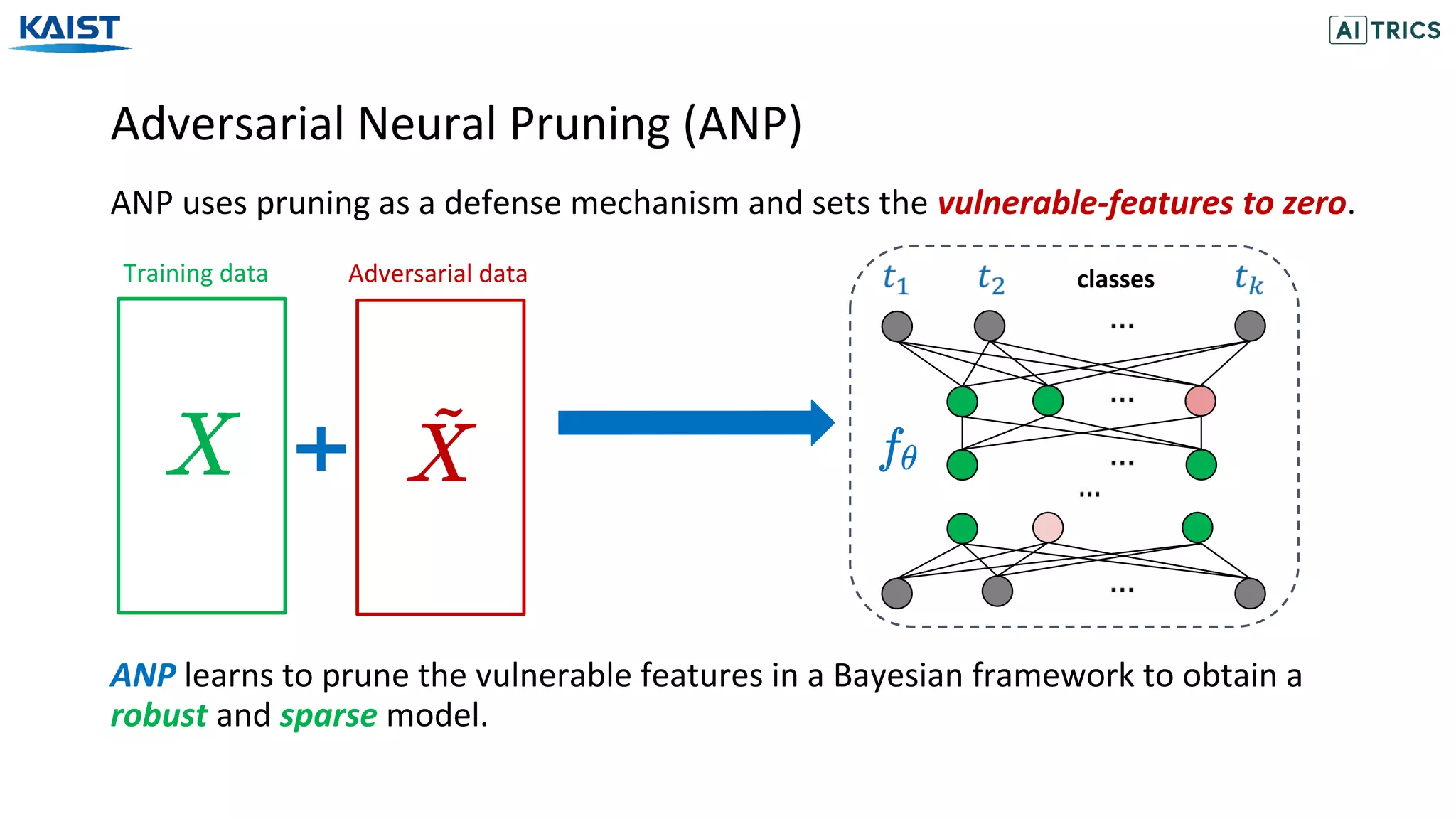
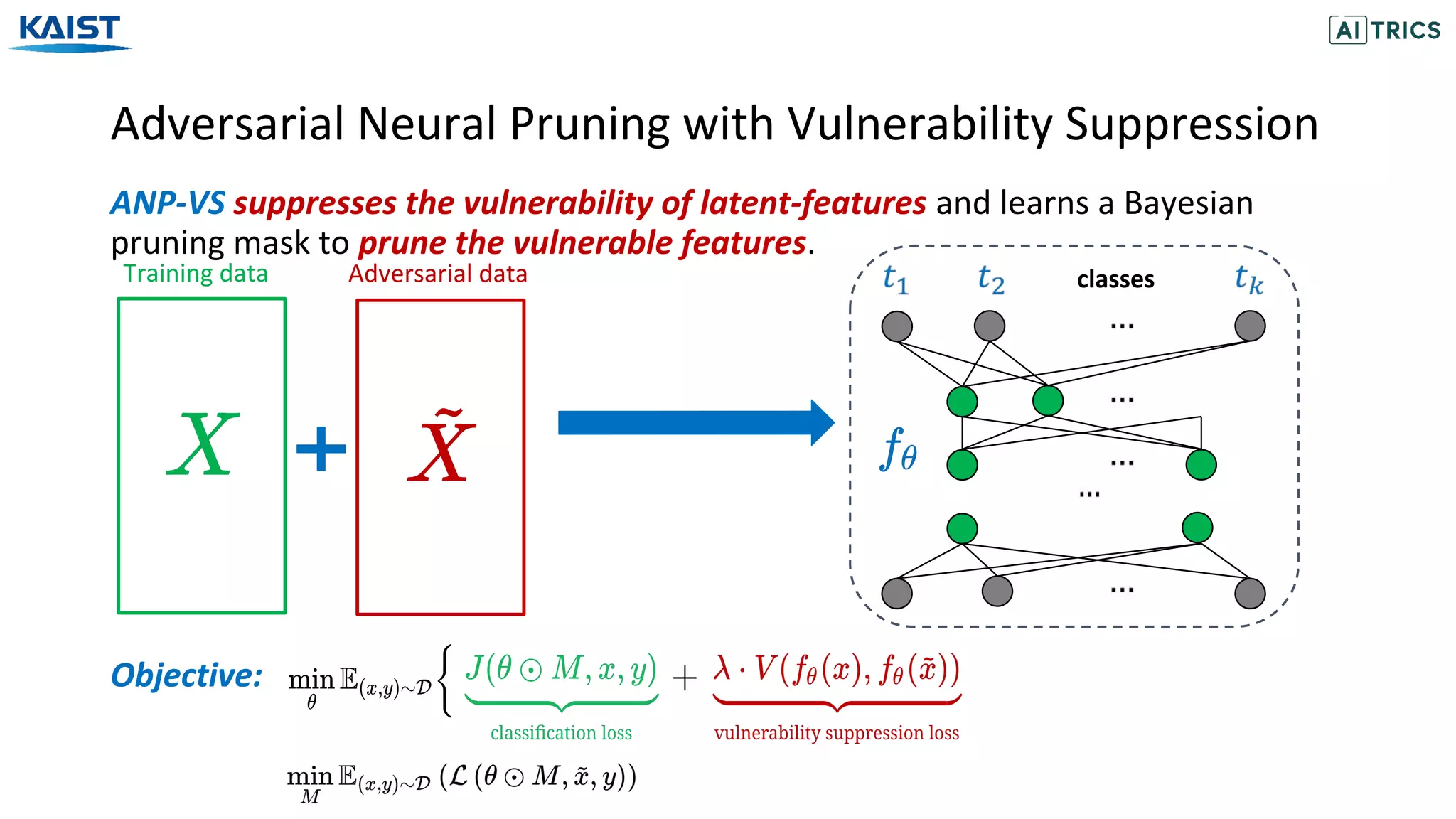
![Adversarial Beta-Bernoulli Dropout
ANP with Beta-Bernoulli Dropout [Lee et al., 2018] models the dropout probability
for each channel/neuron with the sparsity inducing Beta-Bernoulli distribution.
Convolution layers with n channels
The activated channels/neurons are modelled according to the Bernoulli distribution.
[Lee et al., 2018] Adaptive Network Sparsification via Dependent Variational Beta-Bernoulli Dropout. arXiv preprint arXiv:1805.10896](https://image.slidesharecdn.com/adversarialneuralpruningwithlatentvulnerabilitysuppression-200723082919/75/Adversarial-Neural-Pruning-with-Latent-Vulnerability-Suppression-16-2048.jpg)
![Adversarial Beta-Bernoulli Dropout
ANP with Beta-Bernoulli Dropout [Lee et al., 2018] generates dropout mask from
sparsity inducing Beta-Bernoulli prior.
Objective:
[Lee et al., 2018] Adaptive Network Sparsification via Dependent Variational Beta-Bernoulli Dropout. arXiv preprint arXiv:1805.10896
ANP is general, and can be applied to any Bayesian pruning technique.](https://image.slidesharecdn.com/adversarialneuralpruningwithlatentvulnerabilitysuppression-200723082919/75/Adversarial-Neural-Pruning-with-Latent-Vulnerability-Suppression-17-2048.jpg)
![Dataset
We evaluate our model and baselines on three benchmark datasets.
[Krizhevsky, 2012] Krizhevsky, A. Learning multiple layer of features from tiny images. University of Toronto 2012
[Lecun, 1998] Lecun, Y. The MNIST database of handwritten digits.
MNIST [Lecun, 1998]
A dataset with 60,000
gray scale images of
handwritten digits with
ten classes.
CIFAR10 [Krizhevsky, 2012]
A dataset with 60,000
images from ten animal and
vehicle classes.
CIFAR100 [Krizhevsky, 2012]
A dataset with 60,000
images from 100 generic
object classes.](https://image.slidesharecdn.com/adversarialneuralpruningwithlatentvulnerabilitysuppression-200723082919/75/Adversarial-Neural-Pruning-with-Latent-Vulnerability-Suppression-18-2048.jpg)
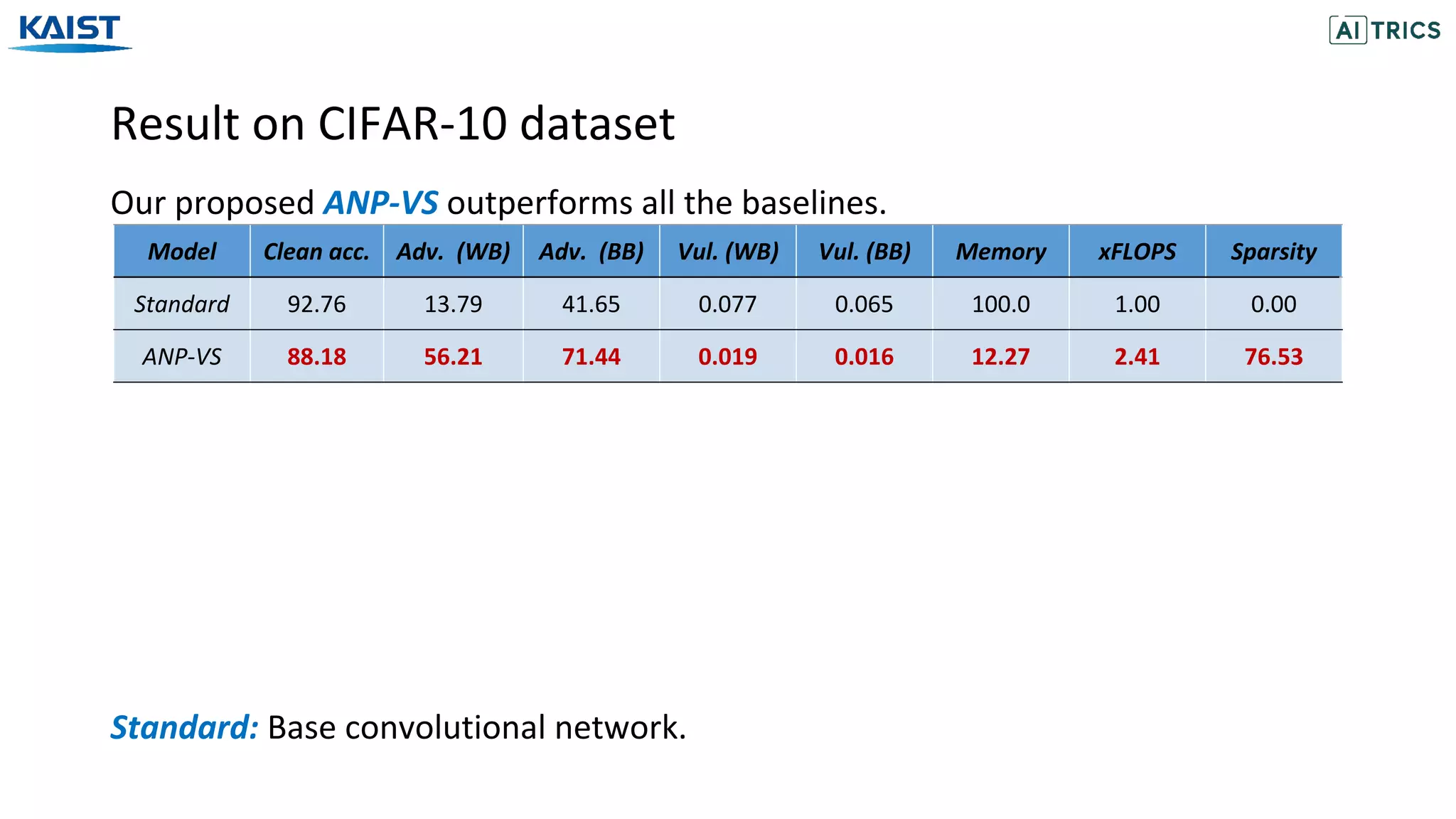
![Result on CIFAR-10 dataset
Our proposed ANP-VS outperforms all the baselines.
Bayesian Pruning (BP) [Lee et al., 2018]: Base network with Beta-bernoulli dropout.
Model Clean acc. Adv. (WB) Adv. (BB) Vul. (WB) Vul. (BB) Memory xFLOPS Sparsity
Standard 92.76 13.79 41.65 0.077 0.065 100.0 1.00 0.00
BP 92.91 14.30 42.88 0.037 0.033 12.41 2.34 75.92
ANP-VS 88.18 56.21 71.44 0.019 0.016 12.27 2.41 76.53
[Lee et al., 2018] Adaptive Network Sparsification via Dependent Variational Beta-Bernoulli Dropout. arXiv preprint arXiv:1805.10896](https://image.slidesharecdn.com/adversarialneuralpruningwithlatentvulnerabilitysuppression-200723082919/75/Adversarial-Neural-Pruning-with-Latent-Vulnerability-Suppression-20-2048.jpg)
![Result on CIFAR-10 dataset
Our proposed ANP-VS outperforms all the baselines.
Adversarial Training (AT) [Kurakin et al., 2016, Madry et al., 2016]: Adversarial
trained network.
Model Clean acc. Adv. (WB) Adv. (BB) Vul. (WB) Vul. (BB) Memory xFLOPS Sparsity
Standard 92.76 13.79 41.65 0.077 0.065 100.0 1.00 0.00
BP 92.91 14.30 42.88 0.037 0.033 12.41 2.34 75.92
AT 87.50 49.85 63.70 0.050 0.047 100.0 1.00 0.00
ANP-VS 88.18 56.21 71.44 0.019 0.016 12.27 2.41 76.53
[Kurakin et al., 2016] Adversarial Machine Learning at Scale. ICLR 2016
[Madry et al., 2016] Towards deep learning models resistant to adversarial attacks. ICLR 2018](https://image.slidesharecdn.com/adversarialneuralpruningwithlatentvulnerabilitysuppression-200723082919/75/Adversarial-Neural-Pruning-with-Latent-Vulnerability-Suppression-21-2048.jpg)
![Result on CIFAR-10 dataset
Our proposed ANP-VS outperforms all the baselines.
AT BNN [Liu et al., 2019]: Adversarial Bayesian trained neural network.
Model Clean acc. Adv. (WB) Adv. (BB) Vul. (WB) Vul. (BB) Memory xFLOPS Sparsity
Standard 92.76 13.79 41.65 0.077 0.065 100.0 1.00 0.00
BP 92.91 14.30 42.88 0.037 0.033 12.41 2.34 75.92
AT 87.50 49.85 63.70 0.050 0.047 100.0 1.00 0.00
AT BNN 86.69 51.87 64.92 0.267 0.238 200.0 0.50 0.00
ANP-VS 88.18 56.21 71.44 0.019 0.016 12.27 2.41 76.53
[Liu et al., 2019] ADV-BNN: Improved Adversarial Defense Through Robust Bayesian Neural Network. ICLR 2019](https://image.slidesharecdn.com/adversarialneuralpruningwithlatentvulnerabilitysuppression-200723082919/75/Adversarial-Neural-Pruning-with-Latent-Vulnerability-Suppression-22-2048.jpg)
![Result on CIFAR-10 dataset
Our proposed ANP-VS outperforms all the baselines.
Pretrained AT (Pre. AT) [Hendrycks et al., 2019]: Adversarial training on a pretrained
base model.
Model Clean acc. Adv. (WB) Adv. (BB) Vul. (WB) Vul. (BB) Memory xFLOPS Sparsity
Standard 92.76 13.79 41.65 0.077 0.065 100.0 1.00 0.00
BP 92.91 14.30 42.88 0.037 0.033 12.41 2.34 75.92
AT 87.50 49.85 63.70 0.050 0.047 100.0 1.00 0.00
AT BNN 86.69 51.87 64.92 0.267 0.238 200.0 0.50 0.00
Pre. AT 87.50 52.25 66.10 0.041 0.036 100.0 1.00 0.00
ANP-VS 88.18 56.21 71.44 0.019 0.016 12.27 2.41 76.53
[Hendrycks et al., 2019] Using Pre-Training can Improve Model Robustness and Uncertainty. ICML 2019](https://image.slidesharecdn.com/adversarialneuralpruningwithlatentvulnerabilitysuppression-200723082919/75/Adversarial-Neural-Pruning-with-Latent-Vulnerability-Suppression-23-2048.jpg)
![Result on CIFAR-10 dataset
Our proposed ANP-VS outperforms all the baselines.
ADMM [Ye et al., 2019]: Concurrent weight pruning and adversarial training.
Model Clean acc. Adv. (WB) Adv. (BB) Vul. (WB) Vul. (BB) Memory xFLOPS Sparsity
Standard 92.76 13.79 41.65 0.077 0.065 100.0 1.00 0.00
BP 92.91 14.30 42.88 0.037 0.033 12.41 2.34 75.92
AT 87.50 49.85 63.70 0.050 0.047 100.0 1.00 0.00
AT BNN 86.69 51.87 64.92 0.267 0.238 200.0 0.50 0.00
Pre. AT 87.50 52.25 66.10 0.041 0.036 100.0 1.00 0.00
ADMM 78.15 47.37 62.15 0.034 0.030 100.0 1.00 75.00
ANP-VS 88.18 56.21 71.44 0.019 0.016 12.27 2.41 76.53
[Ye et al., 2019] Adversarial Robustness vs. Model Compression, or Both? ICCV 2019](https://image.slidesharecdn.com/adversarialneuralpruningwithlatentvulnerabilitysuppression-200723082919/75/Adversarial-Neural-Pruning-with-Latent-Vulnerability-Suppression-24-2048.jpg)
![Result on CIFAR-10 dataset
Our proposed ANP-VS outperforms all the baselines.
TRADES [Zhang et al., 2019]: Explicit trade-off between natural and robust
generalization.
Model Clean acc. Adv. (WB) Adv. (BB) Vul. (WB) Vul. (BB) Memory xFLOPS Sparsity
Standard 92.76 13.79 41.65 0.077 0.065 100.0 1.00 0.00
BP 92.91 14.30 42.88 0.037 0.033 12.41 2.34 75.92
AT 87.50 49.85 63.70 0.050 0.047 100.0 1.00 0.00
AT BNN 86.69 51.87 64.92 0.267 0.238 200.0 0.50 0.00
Pre. AT 87.50 52.25 66.10 0.041 0.036 100.0 1.00 0.00
ADMM 78.15 47.37 62.15 0.034 0.030 100.0 1.00 75.00
TRADES 80.33 52.08 64.80 0.045 0.042 100.0 1.00 0.00
ANP-VS 88.18 56.21 71.44 0.019 0.016 12.27 2.41 76.53
[Zhang et al., 2019] Theoretically Principled Trade-off between Robustness and Accuracy. ICML 2019](https://image.slidesharecdn.com/adversarialneuralpruningwithlatentvulnerabilitysuppression-200723082919/75/Adversarial-Neural-Pruning-with-Latent-Vulnerability-Suppression-25-2048.jpg)
